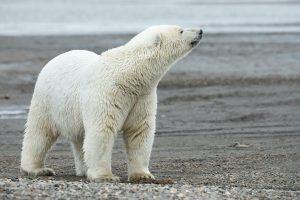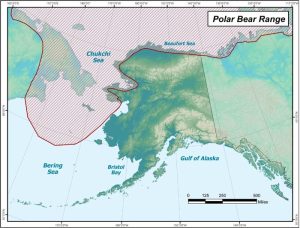Topics - Alaska
Alaska
Arctic Polar Bear, Ursus maritimus
 While climate change causes global impacts, the Arctic and Antarctica are undergoing the most change as a result of a warmer world. In the past 60 years, Alaska has warmed 3°C, a rate nearly twice as fast as the rest of the United States.1 Some models suggest there could be an ice-free Arctic in the summer before 2050.2 The endangered Arctic region serves as critical habitat for endemic species such as the polar bear that depend on sea ice for survival.
While climate change causes global impacts, the Arctic and Antarctica are undergoing the most change as a result of a warmer world. In the past 60 years, Alaska has warmed 3°C, a rate nearly twice as fast as the rest of the United States.1 Some models suggest there could be an ice-free Arctic in the summer before 2050.2 The endangered Arctic region serves as critical habitat for endemic species such as the polar bear that depend on sea ice for survival.
Polar bears hunt off sea ice in the summer. Polar bears are poor terrestrial hunters due to the high level of energy expended when walking; as a result, they depend greatly on aquatic marine life for survival. Polar bears have the capability to swim for extended periods of time; however, if they do not have a reasonable rest on ice packs or land, polar bears can die of exhaustion. Likewise, as sea ice melts, the bears must swim increasingly long distances from one floe to another, increasing the likelihood of exhaustion and drowning. Polar bears come ashore when sea ice melts, and as sea ice melts earlier each year, the bears are in worse health when ashore.3 Polar bear populations are also threatened by toxic chemicals in the food chain caused by chemical spills or plastic and trash pollution in the ocean, contact with oil spills, and hunting, particularly as interactions between humans and polar bears increase.
 Habitat degradation contributes to declining cub survival rates and unstable denning conditions. Litter sizes are decreasing with climate change. As a survival mechanism, the female bear has the natural ability to abort if her body lacks nutritional content. This ultimately leads to a decreasing population growth of an already low reproducing species.4 Further, increasing temperatures are causing dens to collapse and other disruptions leading to low survival rates of cubs. Half of maternal denning occurs on the ice pack. When a female polar bear consumes toxic chemicals present in the Arctic food chain, these chemicals can be high in concentration in the mother bear’s milk. The milk can then poison the cubs, leading to lower survival rates.
Habitat degradation contributes to declining cub survival rates and unstable denning conditions. Litter sizes are decreasing with climate change. As a survival mechanism, the female bear has the natural ability to abort if her body lacks nutritional content. This ultimately leads to a decreasing population growth of an already low reproducing species.4 Further, increasing temperatures are causing dens to collapse and other disruptions leading to low survival rates of cubs. Half of maternal denning occurs on the ice pack. When a female polar bear consumes toxic chemicals present in the Arctic food chain, these chemicals can be high in concentration in the mother bear’s milk. The milk can then poison the cubs, leading to lower survival rates.
The polar bear is an important part of the food chain of all species in the Arctic, including humans who rely on this food source as part of their subsistence lifestyle. The communities of Point Hope, Kivalina, Bering Strait/St Lawrence Island, Barrow, Shishmaref, Atqasuk, and Wainwright are known to hunt and consume polar bears. In May 2008 the polar bear was listed as a threatened species under the Endangered Species Act. Subsistence harvest of the polar bear by Alaska Natives is still allowed as it is not deemed to be a threat to the species. The best way to preserve the remaining species is to transition away from utilizing fossil fuels, as that is causing the most destruction of their habitat. However, taking the species into captivity is another means of preventing extinction.
Polar Bears and Humans
In 2019, Alaska Scientists at USGS found that changes in sea ice had coincided with evidence that polar bears’ onshore habitation was increasing, and that chances of a polar bear encounter had risen.5 In 2023, a mother and her child had a fatal encounter with a polar bear in Wales, Alaska. This was the first fatal encounter with a polar bear in the village in 30 years. As polar bears’ sea ice habitats continue to disappear, and they travel farther inland, fatal interactions with polar bears may increase. As the climate and ecosystems of the north change, so do the behaviors of living organisms. Protecting their habitat is important for the preservation of the species, but also for the safety of people in high latitude regions. Climate change may indeed be a piece of this puzzle. As the climate and ecosystems of the north change, so do the behaviors of living organisms. Is this a bear that is adapting to the changing environment? Polar bears will need to find a new way to exist as the amount of sea ice decreases. Human beings may have to adapt along with the bears and realize that interactions between the species may become a frequent occurrence.
Sources:
- National Climate Assessment. (2014). Alaska. NCA. Available online from: https://nca2014.globalchange.gov/report/regions/alaska#intro-section [accessed January 24, 2023].
- World Wildlife Fund. (2021). Polar Bears and Climate Change. WWF. Available online from: https://www.worldwildlife.org/pages/polar-bears-and-climate-change [accessed January 24, 2023].
- World Wildlife Fund. (2021). Polar Bear Threats. WWF. Available online from: https://www.arcticwwf.org/wildlife/polar-bear/polar-bear-threats/ [accessed January 24, 2023].
- Péter K. Molnár, Andrew E. Derocher, Tin Klanjscek, Mark A. Lewis. (February 8, 2011). Predicting climate change impacts on polar bear litter size. Nature Communications. Available online from: https://www.sciencedaily.com/releases/2011/02/110208112647.htm [accessed January 24, 2023].
- USGS. (November 1, 2022). Without Sea Ice, More Polar Bears Spend Time Onshore, Increasing Potential for Human Interaction. USGS. Available online from: https://www.usgs.gov/news/state-news-release/without-sea-ice-more-polar-bears-spend-time-onshore-increasing-potential [accessed January 24, 2023].
CONNECT WITH US
Nikki Cooley
Co-Director
Nikki.Cooley@nau.edu
Karen Cozzetto
Manager
Karen.Cozzetto@nau.edu
Your tax deductible donation supports ITEP’s programming efforts.
Please contact us if you would like to contribute to our endowment or for any additional information regarding donations.

